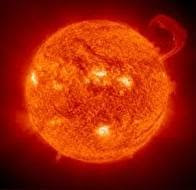The Sun is 149,597,893 km from Earth and has a diameter of 1,391,940 km. This is more than 100 times larger than Earth. Its mass is equivalent to 99.98 percent of the mass of the entire Solar System.
Elements
The sun is mostly made up of two light gases, 75 per cent hydrogen and 23 percent helium, with relatively small quantities of other elements –including metals such as gold. Helium was discovered in the Sun before it was detected on Earth. Its name comes from helios, the Greek word for sun.
Temperature
The Sun has a surface temperature of 5,880 K but it can be 56,000,000 K at its core. At the Sun’s centre, nuclear fusion constantly changes hydrogen into helium, and the energy and heat released from this process rise to the surface. The yellow surface we see is called the photosphere.
The corona
The outermost layer of the Sun extends million of kilometers into space but is visible only during eclipses. At a height of 75,000 km in the corona, the temperature may reach 2,000,000 K.
Rotation
The Sun rotates once every 25.4 days, but because it is not solid, the poles spin at a different rate, taking as much as 36 days to complete a single revolution.
Solar eclipses
When the moon is between Earth and the Sun, it blocks out the light causing a partial or total eclipse. At this time, astronomers are able to able to observe the corona in detail.


Comments
Post a Comment